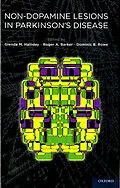Parkinson's disease becomes apparent only after substantial loss (60%) of the dopamine neurons in the substantia nigra. By this time there has already been widespread neural inclusion formation in the peripheral and central nervous system of patients with the disease, although this has only been recognized more recently. Degeneration in these widespread regions of the peripheral and central nervous system is now known to impact on disease symptoms, progression and treatment over time. This book aims to provide a comprehensive review of these non-dopamine lesions in Parkinson's disease by assessing our current knowledge of their presence and pathophysiology, how they relate to different symptoms and, where relevant, discuss how they may be potentially treated. The book addresses most of the known symptoms that occur in patients with Parkinson's disease. In addition to the classic motor triad, motor speech, eye movements, olfactory dysfunction, autonomic dysfunction, pain and sensory abnormalities, sleep disturbances, depression and apathy, dopamine dysregulation syndromes, hallucinations and psychoses, cognitive impairment and dementia, and systemic manifestations are all reviewed. Early selective cell loss in non-dopaminergic regions is highlighted (the glutamate projection neurons of the presupplementary motor cortex and caudal intralaminar thalamus) in addition to the widespread inclusion formation in many regions outside the basal ganglia that characterize the disease. Overall this book provides a comprehensive analysis of the lesions associated with the most common symptoms found in patients with Parkinson's disease.
Autorentext
Glenda M. Halliday, PhD, is a neuroscientist currently working on the pathogenesis of neurodegenerative diseases. Her research has highlighted broader pathological involvement in Parkinson's disease and especially in dementia with Lewy bodies, with recent work suggesting that humoral immunity is involved. Roger A. Barker, PhD did his undergraduate training at the University of Oxford and then St Thomas Hospital in London. For the last 10 years he has been an honorary consultant in Neurology at the Addenbrooke's Hospital in Cambridge as well as being the University Reader in Clinical Neuroscience. He runs a large research group looking at the heterogeneity and natural history of PD as well as a basic science programme of work on the development of novel therapies for PD including stem cell based treatments. Dominic B. Rowe, FRACP, PhD, is Professor of Neurology at Macquarrie University in Sydney, Australia as well as a Consultant Neurologist at The University of Sydney. He first studied biochemistry and medicine and then completed training in internal medicine and neurology in Sydney before completing neurology training at Queen's Square and Newcastle uponTyne. His doctoral studies on the pathogenesis of Parkinson's disease were performed at Baylor College of Medicine, Texas and completed at the University of New South Wales. He has worked clinically as a neurologist and academic. His research is focused on the mechanisms involved in Parkinson's disease and Motor Neurone Disease. He is the chairman of the Motor Neurone Disease Research Institute of Australia and is the author of three textbooks and more than 30 original articles.
Zusammenfassung
Parkinson's disease becomes apparent only after substantial loss (>60%) of the dopamine neurons in the substantia nigra. By this time there has already been widespread neural inclusion formation in the peripheral and central nervous system of patients with the disease, although this has only been recognized more recently. Degeneration in these widespread regions of the peripheral and central nervous system is now known to impact on disease symptoms, progression and treatment over time. This book aims to provide a comprehensive review of these non-dopamine lesions in Parkinson's disease by assessing our current knowledge of their presence and pathophysiology, how they relate to different symptoms and, where relevant, discuss how they may be potentially treated. The book addresses most of the known symptoms that occur in patients with Parkinson's disease. In addition to the classic motor triad, motor speech, eye movements, olfactory dysfunction, autonomic dysfunction, pain and sensory abnormalities, sleep disturbances, depression and apathy, dopamine dysregulation syndromes, hallucinations and psychoses, cognitive impairment and dementia, and systemic manifestations are all reviewed. Early selective cell loss in non-dopaminergic regions is highlighted (the glutamate projection neurons of the presupplementary motor cortex and caudal intralaminar thalamus) in addition to the widespread inclusion formation in many regions outside the basal ganglia that characterize the disease. Overall this book provides a comprehensive analysis of the lesions associated with the most common symptoms found in patients with Parkinson's disease.
Inhalt
TABLE OF CONTENTS Contributors Chapter 1: Lesions Associated with the Classic Triad of Parkinsonian Motor Features Stanley Fahn and Glenda M. Halliday Chapter 2: Lesions Associated with Motor Speech Anna Rita Bentivoglio, Davide Quaranta, and Aileen K. Ho Chapter 3: Lesions Associated with Eye Movements Andrew W. Michell, Roger A. Barker, and Glenda M. Halliday Chapter 4: Olfactory Dysfunction in Parkinson's Disease and Related Disorders Richard L. Doty, Christopher Hawkes, and Henk W. Berendse Chapter 5: Lesions Associated with Autonomic Dysfunction A: Swallowing Disorders and Drooling Maria G. Cersosimo and Eduardo E. Bennarroch B: Gastrointestinal Disorders Adolfo Mínguez-Castellanos and Dominic B. Rowe C: Orthostatic Hypotension Spiridon Papapetropoulos and Kathryn K. Post Chapter 6: Lesions Associated with Pain and Sensory Abnormalities Andreas Hartmann and Glenda M. Halliday Chapter 7: Lesions Associated with Sleep Disturbances Marcus M. Unger, Wolfgang H. Oertel, Thomas C. Thannickal, Yuan-Yang Lai, and Jerome M. Siegel Chapter 8: Lesions Associated with Depression and Apathy Uwe Ehrt, Kenn F. Pedersen, and Dag Aarsland Chapter 9: Lesions Associated with Dyskinesias and the Dopamine Dysregulation Syndrome Andrew H. Evans Chapter 10: Lesions Associated with Visual Hallucinations and Psychoses David R. Williams and Werner Poewe Chapter 11: Lesions Associated with Cognitive Impairment and Dementia Jonathan Evans, Tamas Revesz, and Roger A. Barker Chapter 12: Systemic Manifestations of Parkinson's Disease Dominic B. Rowe Index
